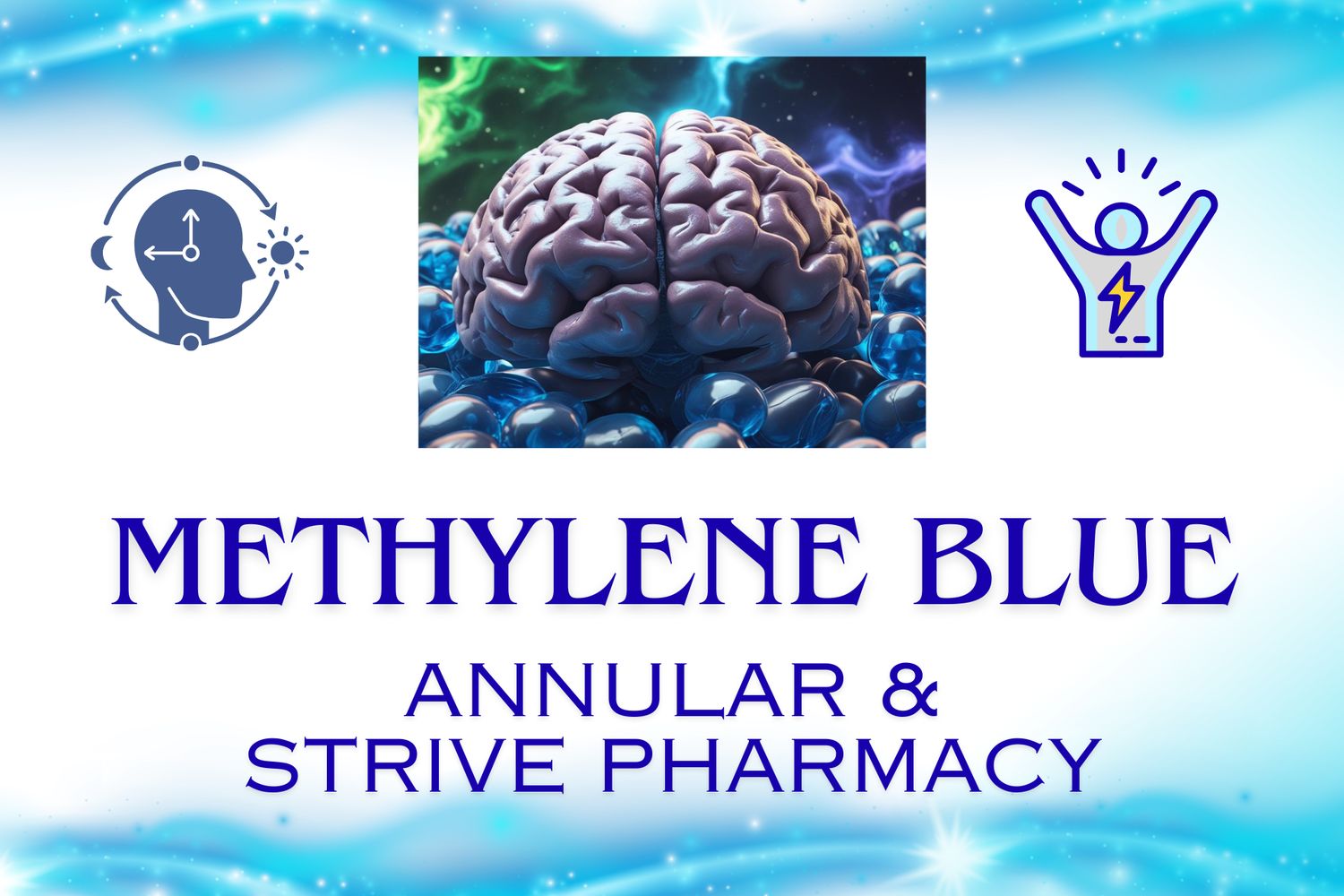Methylene Blue Oral Capsules Service Fee STRIVE PHARMACY
Suggested Dose: Take 10mg to 25mg a day. I recommend taking 10mg a day for one month then increase to 20-25mg a day. The capsules are available in 10mg, 20mg, and 25mg. The capsules cannot be split in half.
You have two options for ordering (depending on your dose):
- 10mg Capsules: You DO NOT need a prescription for this. Anyone can order this in any state. Click HERE to order.
- ANNULAR (rebranded from Strive OTC Peptides) is the best source for the oral option. These will be shipped directly from them after you order.
- You can click above or go to www.annular.com/LKEELING to order through my professional link. This allows you to order one bottle for $120 or use the Subscribe & Save feature with autoship and pay $102 a bottle (shipped and billed monthly).
- You may take 1-2 capsules a day. The bottle contains #60 10mg capsules.
- You do NOT need a prescription or a Push Health account for these.
- You may order in bulk for family. These are not patient-specific, so they can be shared with friends or family members if needed.
- 20mg or 25mg capsules: You DO need a prescription for this. You order your medication here through the Order Site like you do with other prescription meds. All of my patients EXCEPT those in AR, CT, IN, KY, MI, MN, and SC can order these. These are due to state restrictions for these meds.
- You must be a patient and have a Push Health Account.
- You must read and sign the Methylene Blue Medical Form found HERE.
- You must pay a $10 invoice to have your medication submitted to the pharmacy. However, multiple items placed in one order will only have one fee. For example, if you order TZ, a face cream, NAD+ injection, LDN tablets, and these methylene blue capsules at the same time, you will only pay one $10 fee. We will submit the invoice to you through your Push Health account after your order is reviewed.
- These will be shipped to you directly from Strive Pharmacy.
- These are prescription capsules, therefore must be used only by the patient. Please do not share them with anyone.
Methylene blue is nootropic that enhances mitochondrial function to boost energy, support physical health, and improve cognitive performance. It also offers antioxidant and neuroprotective benefits, potentially helping to slow the progression of age-related neurological diseases.
Potential Benefits
Some of the potential benefits include but are not limited to:
- Anti-aging effects by enhancing mitochondrial function
- Neuroprotective effects, with potential in the management of Alzheimer’s and Parkinson’s diseases
- Antioxidant and anti-inflammatory effects
- Enhanced cellular energy regulation via increased ATP synthesis and mitochondrial function
- Improvement in energy levels, brain fog, depressed mood, and anxiety levels
- Chronic Fatigue and Long-Covid
- Chronic Lyme Disease
Treatment Protocol
Methylene Blue holds an indication for the treatment of methemoglobinemia, where it acts as a reducing agent to restore the oxygen-carrying capacity of hemoglobin. Beyond this use, it has also been studied for its potential in managing Lyme disease and co-infections such as Bartonella, due to its antimicrobial properties, ability to penetrate biofilms, and potential to target persistent forms of Borrelia burgdorferi.
Potential Side Effects
Methylene Blue is generally well-tolerated, but potential side effects may include:
- Blue discoloration of urine
- Blue discoloration of mouth cavity with the troche
- Headaches
- Nausea
- Increased blood pressure or dizziness, especially if taken in higher doses
Drug interactions
- There is a potential risk of serotonin syndrome when used concurrently with serotonergic agents such as SSRIs and trazodone. Providers should monitor for signs of serotonin excess, including agitation, confusion, tremor, or autonomic instability, in patients on multiple serotonergic medications.
Precautions
- Methylene Blue is contraindicated in patients with glucose-6-phosphate dehydrogenase deficiency (G6PD) due to the risk of hemolytic anemia
How It Works
Methylene Blue works primarily by enhancing mitochondrial function. It supports the electron transport chain, which improves mitochondrial function and increases ATP (adenosine triphosphate) synthesis. Methylene Blue also acts as a potent antioxidant, neutralizing harmful free radicals that can cause cellular damage. It helps modulate the body’s inflammatory response, which can be beneficial in reducing inflammation-related damage
Q. Can I take take Methylene Blue with SSRI medications?
A. Methylene Blue poses a theoretical risk of serotonin syndrome, a rare but dangerous drug interaction where high amounts of serotonin produced cause symptoms like diarrhea, agitation, increased heartbeat and blood pressure. Though serotonin syndrome has been observed with intravenous methylene blue, typical oral doses are much lower. I recommend these patients take the 10mg a day dose.

